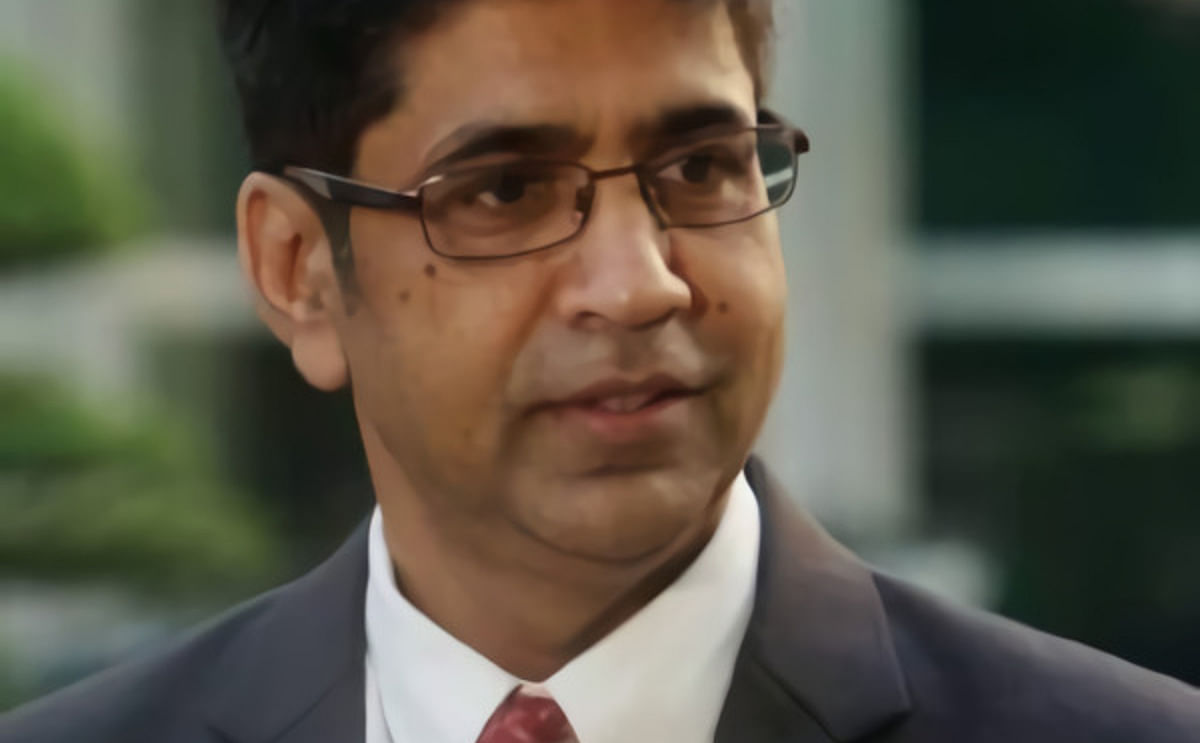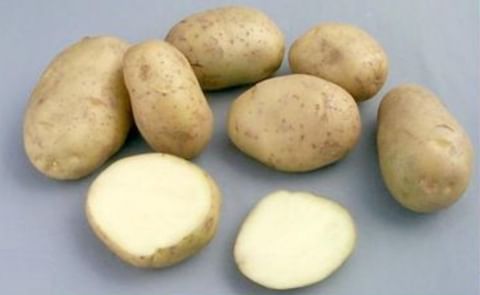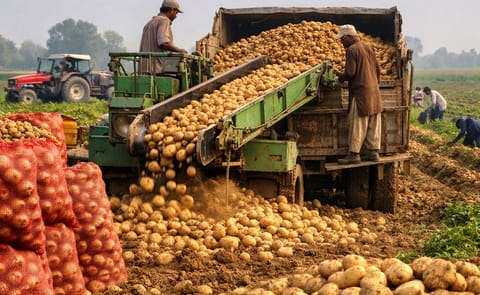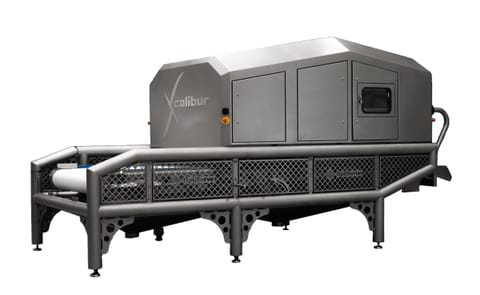Interview with Samarendu Mohanty, Asia Regional Director at the International Potato Center (CIP)
Solapas principales
Potato farming in Odisha, India: Interview with Samarendu Mohanty, Asia Regional Director at the International Potato Center (CIP)

Mr. Samarendu Mohanty is a creative, dynamic, and effective agricultural research manager and administrator with an excellent educational background, a strong publication record, and extensive expertise in commodity marketing, trade and policy analysis, futures market and technology dissemination & large-scale impact for smallholders.
He is an excellent communicator at all levels. Mr. Samarendu Mohanty is a native of Bhubaneswar, Odisha. In the 1980s, engineering was at its peak, and everyone, including Samarendu and his friends, desired to attend engineering college.
With just two engineering colleges (Rourkela and Burla) in the state at that time, Mr. Mohanty attempted entrance exams for for two years but was unsuccessful.
However, he never gave up and proceeded to Bangalore for his bachelor’s degree in agricultural marketing and cooperation, where he completed his degree as a topper with nine gold medals.
After completing his bachelor’s degree, he proceeded to the United States for his master’s degree with full scholarship and later completed his doctorate in agricultural economics.
He worked as a professor both at Iowa State University and Texas Tech University y for 15 years. After spending 20 years in the United States, he decided to return to Asia. He jointed as the head of the social sciences division and program leader at International Rice Research Institute (IRRI) in the Philippines.
After spending 9 years at IRRI, he joined International Potato Center (CIP) as the Asia Regional Director.
Soon after joining CIP, he realized that potato seed is the biggest constraint for millions of poor potato farmers in India, particularly in Odisha. Therefore, he brought a new low-cost seed production technology "apical rooted cutting (ARC)" from Vietnam.
Kindly inform us more about ( CIP ) and how ( CIP) works globally.
Samarendu Mohanty:
Samarendu Mohanty:
Samarendu Mohanty:
Samarendu Mohanty:
Samarendu Mohanty:
Samarendu Mohanty:
Samarendu Mohanty:
Samarendu Mohanty:
Samarendu Mohanty:
Samarendu Mohanty:
Samarendu Mohanty:
Samarendu Mohanty:
Samarendu Mohanty:
As a global agribusiness leader, what message do you want to convey to the world’s young and farmers?
Samarendu Mohanty:
He is an excellent communicator at all levels. Mr. Samarendu Mohanty is a native of Bhubaneswar, Odisha. In the 1980s, engineering was at its peak, and everyone, including Samarendu and his friends, desired to attend engineering college.
With just two engineering colleges (Rourkela and Burla) in the state at that time, Mr. Mohanty attempted entrance exams for for two years but was unsuccessful.
However, he never gave up and proceeded to Bangalore for his bachelor’s degree in agricultural marketing and cooperation, where he completed his degree as a topper with nine gold medals.
After completing his bachelor’s degree, he proceeded to the United States for his master’s degree with full scholarship and later completed his doctorate in agricultural economics.
He worked as a professor both at Iowa State University and Texas Tech University y for 15 years. After spending 20 years in the United States, he decided to return to Asia. He jointed as the head of the social sciences division and program leader at International Rice Research Institute (IRRI) in the Philippines.
After spending 9 years at IRRI, he joined International Potato Center (CIP) as the Asia Regional Director.
Soon after joining CIP, he realized that potato seed is the biggest constraint for millions of poor potato farmers in India, particularly in Odisha. Therefore, he brought a new low-cost seed production technology "apical rooted cutting (ARC)" from Vietnam.
Kindly inform us more about ( CIP ) and how ( CIP) works globally.
Samarendu Mohanty:
"The International Potato Centre (CIP) is non-profit international agricultural research organization with a global mandate to conduct research on genetic resources of potatoes, sweet potatoes, and other Andean roots and tubers, crop genetic enhancement and improvement, integrated crop management and sustainable management of natural resources."Is there a factor or barrier preventing Odisha farmers from progressing, particulary in potato farming?
"Our genebank is one of the largest in vitro genebanks in the world and contains the global collection of potato, sweetpotatoes and Andean root and tuber."
"In the last five decades, CIP has supplied over 14,00 accessions (advanced clones, parents and trues seed families for clonal selection) of diversified potato groups to India to develop new varieties through breeding or release locally adapted varieties."
"Similarly, in case of sweetpotato, CIP has exchanged elite germplasm that were procured from CIP-Lima. In 2018, CIP provided 20,000 orange flesh sweet potato true seeds to Central Tuber Crops Research Institute (CTCRI)."
"We also work in several states in India including Odisha, Haryana, Karnataka, Bihar, Assam, Meghalaya, Tripura and others in improving livelihood of potato and sweetpotato farmers through new varieties, quality planting materials and market linkages."
Samarendu Mohanty:
"At present, Odisha agriculture is mostly subsistence in nature, with a majority of the farmers growing crops for their own household consumption."What developments and opportunities available in the agricultural field?
"Rice is the primary food crop grown in the state, occupying slightly less than half of the total gross cropped area, and 90 percent of the total rice is produced in the kharif season using monsoon water."
"With the problems in traditional food baskets of India, the country will be looking more and more at Odisha and other eastern states to expand rice area in the rabi season using groundwater to contribute to national food security."
"But this will require the use of highly precious groundwater to produce water-guzzling rice crops in the rabi season (5,000 liters of water are used to produce one kilogram of rice). The expansion of irrigated rice in the rabi season is unlikely to provide the necessary boost in income to most of the farmers in the state."
"Odisha needs to be proactive in transforming rice-centric subsistence agriculture into a diversified farming business. This will improve the livelihood of small farmers and make it attractive for rural youth to take up agriculture as a business."
"The state should start developing agricultural infrastructure, including irrigation, cold storage, market linkages, and mechanization, among others, to enable farmers to take up high-value agriculture, including fruits and vegetables, highly nutritious and climate-resilient roots and tubers, floriculture, livestock, fisheries, and milk production."
"To allow progressive farmers to expand their operations beyond their own small holdings, formalization of land leasing agreements between landlords and tenants is needed."
"This will remove the fear on the part of landlords of losing the land to tenants and, at the same time, tenants will be recognized as the operators of land and they can apply for an institutional loan, insurance, and disaster relief."
"But at the same time, the state needs to be prudent in its use of ground water in transforming the agriculture sector. Not many states in India have more than 3 million hectares of fallow land in the rabi season and groundwater a few meters from the surface level."
"With land and water, Odisha holds the trump card for India’s future food and nutrition security. If not prudent, the state can easily fall into the same trap as Punjab and Haryana with high environmental degradation and depleted groundwater 30 years from now."
"These states are now facing increasing environmental degradation because of the excessive application of fertilizer and pesticide and rapid groundwater depletion because of double monocropping of rice and wheat."
"Couple of years ago, we (at the International Potato Center) facilitated the visit of a group of large potato farmers from Haryana to the state. This group visited several potato-growing districts, including Koraput, Puri, and Cuttack."
"At the end of the visit, many farmers wanted to purchase land in Koraput and start potato cultivation there. They were surprised to learn that the state produces only 20 percent of its requirement. It is high time for the state to develop a fool-proof strategy for transforming its subsistence agriculture into high-flying commercial agriculture."
"To make this happen, the state needs its young minds, both men and women, driving this transformation. Agriculture should be the pride of our state and our farmers should proudly send their sons and daughters into farming without worrying that their profession will be the reason for their being unmarried ."
Samarendu Mohanty:
"At present, agriculture is not an attractive career choice for the majority of youth. Social stigma is attached to pursuing farming as a profession. Even a majority of our farmers do not want their children to follow in their footsteps and continue with farming."How are you helping the farmers in the state?
"They would rather send them to the city to become a security guard or labor as a waiter in a restaurant or in any other odd job but not become involved in farming. Another angle to this story is that the farmers do not want their children to become farmers because it will be difficult to find a bride."
"The children also grow up with the impression from their school days that farming is not a good career choice. I still remember during my school days when teachers used to repeatedly tell us that, if we did not study, we would end up in farming. Eventually, this becomes engraved in children’s minds."
"Despite all this social stigma, the fact is that farming is not attractive for rural youth because it does not provide a decent standard of living."
"If one has one hectare of land (that is the average size of landholding in the state), then this person barely makes INR 20,000 (USD 242) at the end of a rice crop. This means that you make INR 20,000 (USD 242) in five to six months, that is, less than INR 4,000 (USD 48) per month, after all this hard work in the field under hot and humid conditions."
"There is also no guarantee to make that amount because of drought and flood, which can wipe out the entire crop and any profit or even result in lost money."
"Youth will consider farming as a profession only if it is portrayed as a business with decent income potential. It is high time to stop depicting farmers as half-naked men and women toiling in the field like animals.The COVID-19 pandemic should be used to demonstrate that all other sectors can be shut down but not farming. Youth should be exposed to high-tech agriculture that involves robotics, information and communication technology, and nano technology."
"A vibrant and tech-savvy agricultural sector will not only attract youth to be part of it but will also take care of a lot of other problems, including poverty eradication and overall development of the state."
Samarendu Mohanty:
"Let m focus on potato because that is what our organization is focusing on in the state and potato is an important staple for majority of population in the state."Can you describe apical rooted cutting seed production approach?
"Unfortunately, we are now only producing 20 percent of our requirement and the remaining 80 percent is coming from other states like West Bengal and Bihar. The demand for potato in the state will continue to grow in the future with rising per capita consumption and population growth."
"CIP has been working with the state government and other stakeholders to make Odisha self-sufficient in potato. But the biggest constraint in expanding potato production in the state is the unavailability of quality seeds at affordable price and in a timely manner.In India, majority of potato seeds are produced in Punjab and are transported to potato growing states of eastern and southern India including Odisha."
"The high transportation cost is borne by the poor farmers who have to pay high seed prices as well. To make matters worse, the high price does not guarantee high quality, thus making it difficult for small and marginal farmers to invest such a large sum in seed purchases which accounts for nearly half of the total cost of production (INR 75,000-125,000 (USD 908-1514) per hectare)."
"Even if someone wants to invest such a large amount in purchasing quality seeds, there is no guarantee to make profit because of low market price after harvest. That’s the reason, majority of Odisha potato farmers purchase potato which are discarded from human consumption and use it as seeds which results in very low yield."
"We have introduced a very low-cost potato seed production technology “apical rooted cutting (ARC)” in the state to enable small farmers to produce their own seeds and make quality seeds available at cheaper price. If locally produced quality seeds are available then it will be attractive for farmers to expand potato production and make our state self-sufficient in potato."
Samarendu Mohanty:
"ARC is a low-cost technology where the tissue culture plantlets are planted in coco peat either in poly house or shade net to establish mother bed. The apical cuttings of these mother plants are taken every 15 days and replanted in cocopeat for rooting and taking further apical cuttings. In three months, one TC plantlet can produce 70-80 ARCs with some plants producing more than one cutting in 15 days. These rooted cuttings are planted either in open field or shade net depending on location."What government policy can encourage farmers to take up potato cultivation?
"The performance of ARCs in term of number of tubers (generation zero (G0) seeds) is the key to determining the economic viability of this technology."
"Based on our pilots in several states, the number of G0 tubers from ARCs vary quite a bit depending on varieties but range between 8 and 20. Kufri Himalini, recently released CIP line Yusi Maap (Kufri Uday; popularly known by farmers as 7008), Chipsona-3 produce on average of 15-20 G0 seeds whereas some varieties like Kufri Jyoti produce on average of 8 G0 tubers per plant."
"If you can construct a supply chain beginning with tissue culture, nursery, and farmers’ organisations or progressive farmers’ groups, we can start replicating it and become self-sufficient in four to five years, with a 50% reduction in the price of seed."
"If you have excellent seeds, the yield will be doubled overnight. Therefore, we are considering reducing costs and doubling yields; if this occurs, farmers will not be concerned about the market price since they will be able to sell their produce at a cheap price and still profit."
"When farmers complain about the infrastructure and state that cold storage is unavailable, investments will be made in cold storage after output increases. The government has a subsidy rate of 50 percent for setting up cold storage. Therefore, if there is sufficient supply, investors will invest in the establishment of cold storages."
Samarendu Mohanty:
"To encourage, progressive farmers to enter ARC seed production, government can provide subsidy for setting up polyhouse and net houses. In order to minimize the risk of low market price, the government can announce a support price level that covers cost of production. In case, market price falls below the support level, the farmers can be paid the difference between support price and market price."How many potato varieties exist and how can we make potato more nutritious?
Samarendu Mohanty:
"There are more than 5,000 varieties of potato and many of them are highly nutritious. The purple potato is rich in anti-oxidants. We have recently introduced a red skin potato variety "Yusi Maap" which is high in iron and zinc."What environmentally sustainable alternatives to pesticides and chemicals are available?
"But more importantly, potato needs to be consumed in right way, i.e., boiled or grilled. But we are now consuming it in unhealthy manner, i.e., potato chips and french fries. In the kharif season, we will be introducing Yusi Maap in Koraput and make it available for Odisha consumers."
Samarendu Mohanty:
"Sometimes you need pesticides and chemicals to protect your crops, but often farmers do it mechanically, they are so worried about their crops that they continue to spray pesticides even if the crop does not have any diseases, leading to an excessive usage of pesticides."Which is the most secure and appropriate method for farmers to harvest potatoes in the field?
"We can cultivate crops organically, but with a population of 1.4 billion people, it is difficult to meet demand with organic production. The first approach should be to limit the excessive use of pesticides, which requires educating, training, and exposing farmers to information about farming and pesticide usage. Then you must come up with new production practices that require less chemical use. For instance, CIP is growing potatoes using a method known as zero-tillage with straw mulch (PZTM). In this method, after paddy harvest, there is no need for ploughing; instead, the potato seed is placed on top of the paddy stable and then covered with straw."
Samarendu Mohanty:
"Manually growing potatoes is very labour intensive because you have to dig it up and perform many processes, but we have introduced potato planter, in which behind the tractor there is a machine where you can put the seed and it will put the seed inside, then there is a digger which is less than 2 lakh rupees and can be placed behind the tractor to dig it up."Do you think formal education in agriculture to be essential?
"So we are slowly mechanizing both planting and harvesting to cut costs, since there is a labour shortage and farmers in Odisha are eager to mechanise. We are working with more than 20,000 farmers, and they are purchasing their own digger and planter."
Samarendu Mohanty:
"Formal education is beneficial, but I do not believe it is necessary since you learn the most in the field. I have a Ph.D., but I learn the most from farmers in the field. Farmers in the field develop practical solutions to their problems. So you do not need education to be a successful farmer; education is desirable, but its absence does not exclude success."How can a country improve the current condition of a farmer?
Samarendu Mohanty:
"Our problem is that our land holdings are very small; the average land holding is 1 hectare, which is insufficient to feed a family of four and provide for their livelihood and other expenses. If we improve their land holdings, we can double their income and make them better, but eventually people will have to leave agriculture; in developed countries, less than 1% of the population works in agriculture."In agriculture, what are poly house and net house processes?
"Slowly, land rental will emerge; if you are a farmer with one hectare of land, you will rent three to four hectares. People who do not work in agriculture have moved to the city. The farmers can improve efficiency, produce more, and expand their operations because 1 hectare is not enough and buying land is not worth it for agriculture."
"However, if you rent land, you can produce in a larger operational, and since it is mechanised, you can make the operation larger. In this way, you can also attract youth to the industry and earn a decent income."
Samarendu Mohanty:
"You may use poly house and net house to protect your crops from insects, so when you do that the quality of the product is excellent because when you conduct seed production your quality is very important, so we suggest doing the initial process in these structures."What is your aim in Odisha, and what initiatives does cip take to assist farmers?
Samarendu Mohanty:
"My goal is to make Odisha self-sufficient in potato seeds. Once local seeds are available at cheaper price, farmers will expand potato production. I think is it possible to have a seed supply chain in the state that produce enough seeds. Second, we have started introducing orange flesh sweetpotato (OFSP) that is high in vitamin A. Sweetpotato is both staple and cash crop in tribal belts."
As a global agribusiness leader, what message do you want to convey to the world’s young and farmers?
Samarendu Mohanty:
"For odisha farmers there are many opportunities, and farming is not a career to be ashamed of. But in our state, majority of farmers don’t want their kids to enter agriculture. I believe that agriculture is the career of the future since, during the epidemic, every other industry shut down but farming remained open."
"Therefore, I believe that we and India should be proud of the fact that we feed not just 1,4 billion people, but also the whole globe. This career will improve via digitization, mechanisation, and robotics, which will draw a large number of young people to the field. This is the period when everyone is concentrating on agriculture. Agriculture is a great career through which one may earn a respectable life."
¿Te gustaría recibir noticias como esta por correo electrónico? ¡Únete y suscríbete!
Get the latest potato industry news straight to your WhatsApp. Join the PotatoPro WhatsApp Community!
Empresa Destacada
Variedades de papa mencionadas
Contenido Patrocinado
Contenido Patrocinado
Contenido Patrocinado
Contenido Patrocinado










